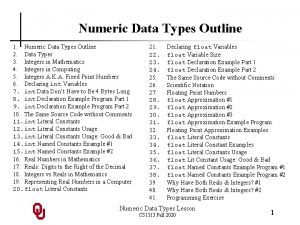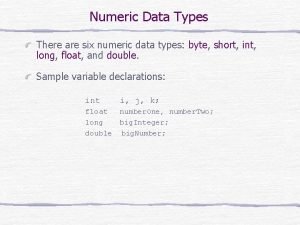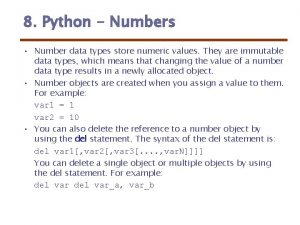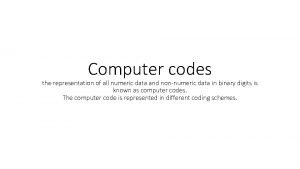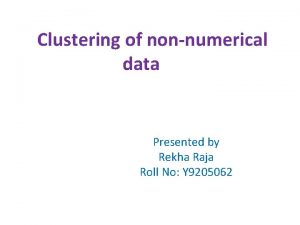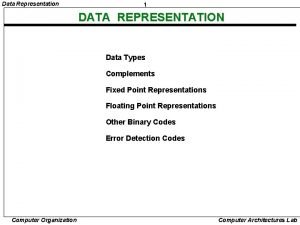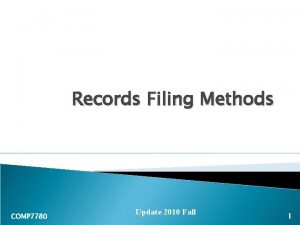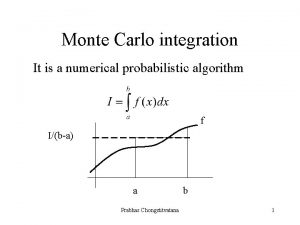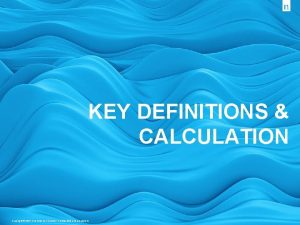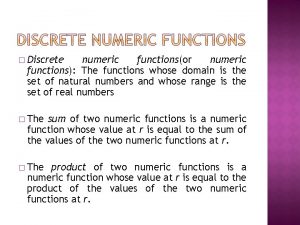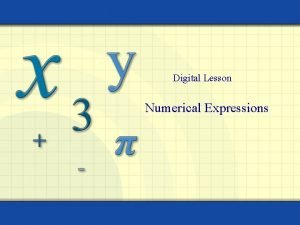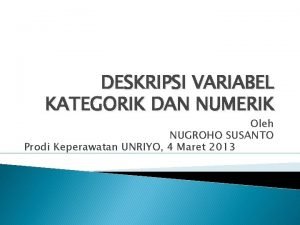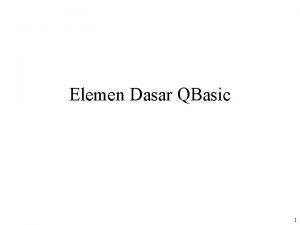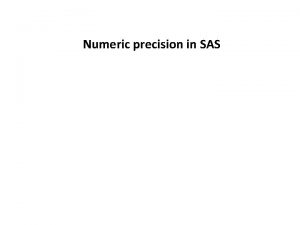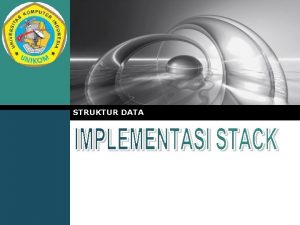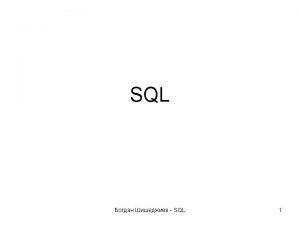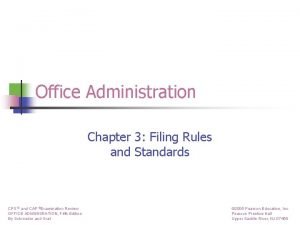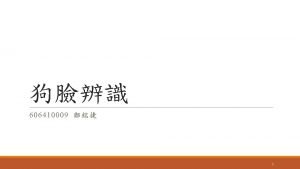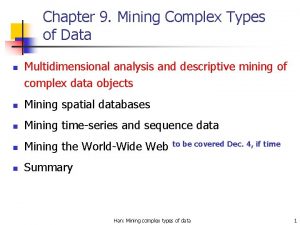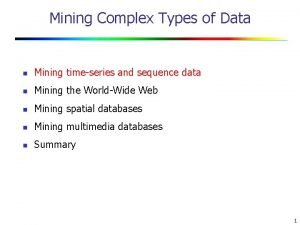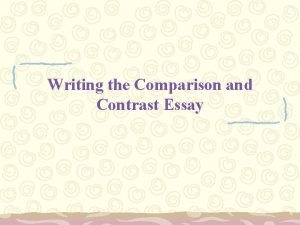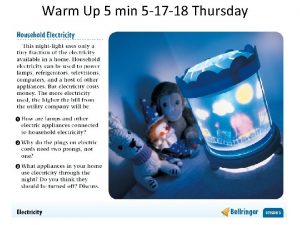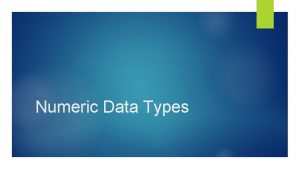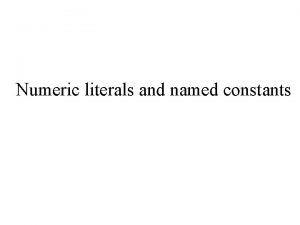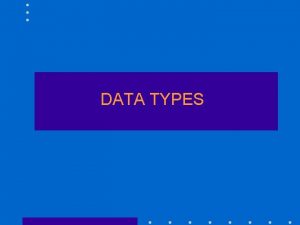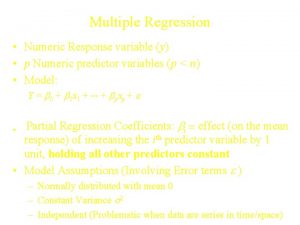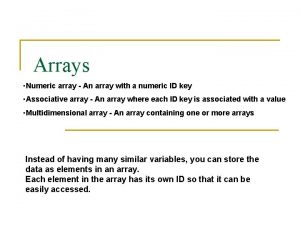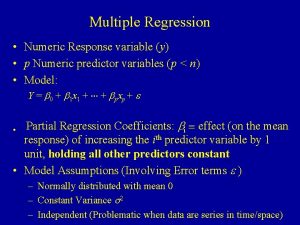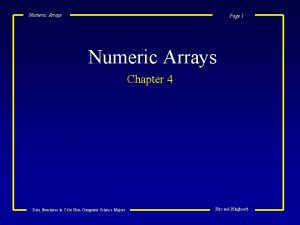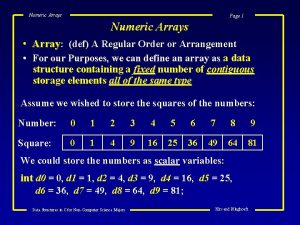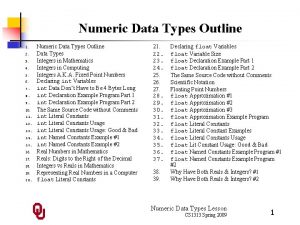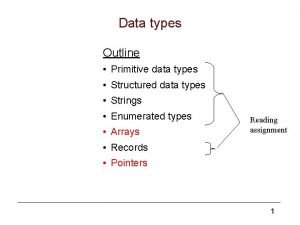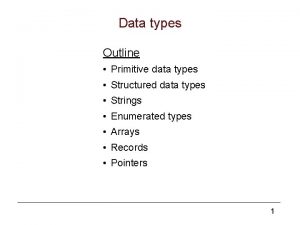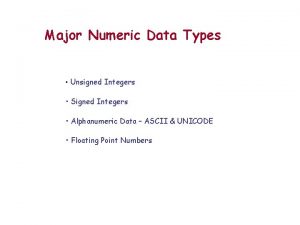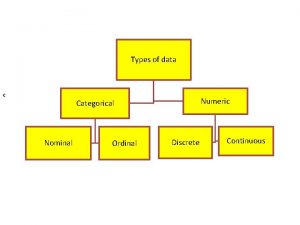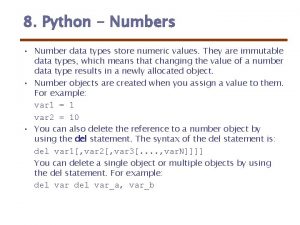Numeric Data Types Outline 1 Numeric Data Types







































- Slides: 39

Numeric Data Types Outline 1. Numeric Data Types Outline 2. Data Types 3. Integers in Mathematics 4. Integers in Computing 5. Integers A. K. A. Fixed Point Numbers 6. Declaring int Variables 7. int Data Don’t Have to Be 4 Bytes Long 8. int Declaration Example Program Part 1 9. int Declaration Example Program Part 2 10. The Same Source Code without Comments 11. int Literal Constants 12. int Literal Constants Usage 13. int Literal Constants Usage: Good & Bad 14. int Named Constants Example #1 15. int Named Constants Example #2 16. Real Numbers in Mathematics 17. Reals: Digits to the Right of the Decimal 18. Integers vs Reals in Mathematics 19. Representing Real Numbers in a Computer 20. float Literal Constants 21. 22. 23. 24. 25. 26. 27. 28. 29. 30. 31. 32. 33. 34. 35. 36. 37. 38. 39. Declaring float Variables float Variable Size float Declaration Example Part 1 float Declaration Example Part 2 The Same Source Code without Comments Scientific Notation Floating Point Numbers float Approximation #1 float Approximation #2 float Approximation #3 float Approximation Example Program float Literal Constants float Literal Constant Examples float Literal Constants Usage float Lit Constant Usage: Good & Bad float Named Constants Example Program #1 float Named Constants Example Program #2 Why Have Both Reals & Integers? #1 Why Have Both Reals & Integers? #2 Numeric Data Types Lesson CS 1313 Spring 2009 1

Data Types A data type is (surprise!) a type of data: n Numeric n n n int: integer float: floating point (also known as real) Non-numeric n char: character #include <stdio. h> int main () { /* main */ float standard_deviation, relative_humidity; int count, number_of_silly_people; char middle_initial, hometown[30]; } /* main */ Numeric Data Types Lesson CS 1313 Spring 2009 2

Integers in Mathematics Mathematically, an integer is any number (positive, negative or zero) that has nothing but zeros to the right of the decimal point: -3984. 0000. . . 0. 0000. . . 23085. 0000. . . Another way to think of integers is as n the counting numbers, and 1, 2, 3, 4, 5, 6, . . . n their negatives (additive inverses), and -1, -2, -3, -4, -5, -6, … n zero. Numeric Data Types Lesson CS 1313 Spring 2009 3

Integers in Computing An integer in computing has the same mathematical properties as an integer in mathematics. An integer in computing also has a particular way of being represented in memory (which we’ll see later in the course) and a particular way of being operated on. In C (and in most computer languages), int literal constants are expressed without a decimal point: -3984 0 23085 Numeric Data Types Lesson CS 1313 Spring 2009 4

Integers A. K. A. Fixed Point Numbers Integers are sometimes known as fixed point numbers, because they have an invisible decimal point in a fixed (unchanging) position. Specifically, every integer’s invisible decimal point is to the right of the rightmost digit (the “ones” digit): -3984 0 23085 invisible decimal point Numeric Data Types Lesson CS 1313 Spring 2009 5

Declaring int Variables int x; This declaration tells the compiler to grab a group of bytes, name them x, and think of them as storing an int. How many bytes? That depends on the platform and the compiler, but these days the typical answer is that an int takes 4 bytes (32 bits) in most cases: x: For example, on Pentium-based Linux PCs such as ssh. ou. edu, using the gcc compiler from gnu. org (the compiler that we’re using in this course), the size of an int is 4 bytes. Numeric Data Types Lesson CS 1313 Spring 2009 6

int Data Don’t Have to Be 4 Bytes Long On some platforms (combination of hardware family and operating system), on some compilers, all ints are 4 bytes. On other platforms, the default int size is 4 bytes, but the size of an int can be changed by using a compiler option. Notice that different compilers for the same language can have different names, different defaults and different options. While there are many common features, compiler vendors are under no compulsion to follow them. Numeric Data Types Lesson CS 1313 Spring 2009 7

int Declaration Example Program Part 1 % cat assign. c /* *********************** *** Program: assign *** Author: Henry Neeman (hneeman@ou. edu) *** Course: CS 1313 010 Spring 2009 *** Lab: Sec 011 Fridays 10: 30 am *** Description: Declares, assigns and *** outputs a variable. ************************ */ #include <stdio. h> int main () { /* main */ /* * ********************* * Declaration section * ********************* * Local variables * ********** * * height_in_cm: my height in cm */ int height_in_cm; Numeric Data Types Lesson CS 1313 Spring 2009 8

int Declaration Example Program Part 2 /* *********************** * Execution section * *********************** * Assign the integer value 160 to height_in_cm. */ height_in_cm = 160; /* * Print height_in_cm to standard output. */ printf("My height is %d cm. n", height_in_cm); } /* main */ % gcc -o assign. c % assign My height is 160 cm. Numeric Data Types Lesson CS 1313 Spring 2009 9

The Same Source Code without Comments % cat assign. c #include <stdio. h> int main () { /* main */ int height_in_cm; height_in_cm = 160; printf("My height is %d cm. n", height_in_cm); } /* main */ % gcc -o assign. c % assign My height is 160 cm. Numeric Data Types Lesson CS 1313 Spring 2009 10

int Literal Constants An int literal constant is a sequence of digits, possibly preceded by an optional sign: CORRECT: 0 -345 768 +12345 INCORRECT: n 1, 234, 567 No commas allowed. n 12. 0 No decimal point allowed. n --4 ++3 A maximum of one sign per int literal constant. n 57+ The sign must come before the digits, not after. Numeric Data Types Lesson CS 1313 Spring 2009 11

int Literal Constants Usage We can use int literal constants in several ways: n In declaring and initializing a named constant: const int w = 0; /* 0 is an int literal constant */ n In initializing a variable (within a declaration): int x = -19; /* -19 is an int literal constant */ n In an assignment: y = +7; /* +7 is an int literal constant */ n In an expression (which we’ll learn more about): z = y + 9; /* 9 is an int literal constant */ Numeric Data Types Lesson CS 1313 Spring 2009 12

int Literal Constants Usage: Good & Bad We can use int literal constants in several ways: n In declaring and initializing a named constant: const int w = 0; /* This is GOOD. */ n In initializing a variable (within a declaration): int x = -19; /* This is GOOD. */ n In an assignment: y = +7; /* This is BAD BAD! */ n In an expression (which we’ll learn more about): z = y + 9; /* This is BAD BAD! */ Numeric Data Types Lesson CS 1313 Spring 2009 13

int Named Constants Example #1 #include <stdio. h> int main () { /* main */ const int number_of_people_to_tango const int number_of_blind_mice const inches_per_foot const int degrees_in_a_circle const int US_drinking_age_in_years = 2; = 3; = 12; = 360; = 21; printf("It takes %d to tango. n", number_of_people_to_tango); printf("n"); printf("%d blind mice, see how they run. n", number_of_blind_mice); printf("n"); printf("There are %d inches in a foot. n", inches_per_foot); printf("n"); printf("There are %d degrees in a circle. n", degrees_in_a_circle); printf("n"); printf("In the US, you can’t legally drink untiln"); printf(" you’re at least %d years old. n", US_drinking_age_in_years); } /* main */ Numeric Data Types Lesson CS 1313 Spring 2009 14

int Named Constants Example #2 % gcc -o intconsts. c % intconsts It takes 2 to tango. 3 blind mice, see how they run. There are 12 inches in a foot. There are 360 degrees in a circle. In the US, you can’t legally drink until you’re at least 21 years old. ASIDE: Notice that you can output a blank line by printing a string literal containing only the newline character n. Numeric Data Types Lesson CS 1313 Spring 2009 15

Real Numbers in Mathematics Mathematically, a real number is a number (positive, negative or zero) with any sequence of digits on either side of the decimal point: -3984. 75 0. 1111111. . . 3. 1415926. . . Numeric Data Types Lesson CS 1313 Spring 2009 16

Reals: Digits to the Right of the Decimal In mathematics, the string of digits to the right of the decimal point can be either: n terminating (a finite number of nonzero digits, maybe even NO nonzero digits), or n repeating (a finite sequence of digits repeated infinitely), or n non-repeating. There are infinitely many real numbers, and in fact infinitely many real numbers between any two real numbers; for example, there are infinitely many real numbers between 0 and 0. 000000001. Numeric Data Types Lesson CS 1313 Spring 2009 17

Integers vs Reals in Mathematics Notice that, in mathematics, all integers are real numbers, but not all real numbers are integers. In particular, mathematically every integer is a real number, because it has a finite number of nonzero digits to the right of the decimal point. Specifically, an integer has NO nonzero digits to the right of the decimal point, so the finite number is zero. Numeric Data Types Lesson CS 1313 Spring 2009 18

Representing Real Numbers in a Computer In a computer, a real value is stored in a finite number of bits (typically 32 or 64 bits), so a computer’s representation of real numbers can only approximate most mathematical real numbers, because only finitely many different values can be stored in a finite number of bits (for example, 32 bits can have only 232 possible different values). Like integers, real numbers have particular ways of being represented in memory (which we’ll look at later in the course) and of being operated on. Numeric Data Types Lesson CS 1313 Spring 2009 19

float Literal Constants In C (and in most computer languages), float literal constants are expressed with a decimal point: -3984. 75 0. 0 23085. 1235 Recall that, in mathematics, all integers are reals, but not all reals are integers. Similarly, in most programming languages, some real numbers are mathematical integers (for example, 0. 0), even though they are represented in memory as reals. In computing, reals are often called floating point numbers. We’ll see why soon. Numeric Data Types Lesson CS 1313 Spring 2009 20

Declaring float Variables float x; This declaration tells the compiler to grab a group of bytes, name them x, and think of them as storing a float, which is to say a real number. How many bytes? That depends on the platform and the compiler, but these days the typical answer is that real numbers take 4 bytes (32 bits) or 8 bytes (64 bits) in most cases: x: x: Numeric Data Types Lesson CS 1313 Spring 2009 21

float Variable Size For example, on Pentium-based Linux PCs such as ssh. ou. edu, using the gcc compiler from gnu. org, which we’re using in this course, the default size of a float is 4 bytes (32 bits). Numeric Data Types Lesson CS 1313 Spring 2009 22

float Declaration Example Part 1 % cat realassign. c /* *********************** *** Program: realassign *** Author: Henry Neeman (hneeman@ou. edu) *** Course: CS 1313 010 Spring 2009 *** Lab: Sec 011 Fridays 10: 30 am *** Description: Declares, assigns and *** outputs a real variable. ************************ */ #include <stdio. h> int main () { /* main */ /* * ********************* * Declaration section * ********************* * Local variables * ********** * * height_in_m: my height in m */ float height_in_m; Numeric Data Types Lesson CS 1313 Spring 2009 23

float Declaration Example Part 2 /* *********************** * Execution section * *********************** * Assign the real value 1. 6 to height_in_m. */ height_in_m = 1. 6; /* * Print height_in_m to standard output. */ printf("My height is %f m. n", height_in_m); } /* main */ % gcc -o realassign. c % realassign My height is 1. 600000 m. Numeric Data Types Lesson CS 1313 Spring 2009 24

The Same Source Code without Comments % cat realassign. c #include <stdio. h> int main () { /* main */ float height_in_m; height_in_m = 1. 6; printf("My height is %f m. n", height_in_m); } /* main */ % gcc -o realassign. c % realassign My height is 1. 600000 m. Numeric Data Types Lesson CS 1313 Spring 2009 25

Scientific Notation In technical classes, we often encounter scientific notation, which is a way of writing numbers that are either very big or very small: 6, 300, 000, 000 = 6. 3 × 1015 0. 00000271 = 2. 71 × 10− 11 In C, we can express such numbers in a similar way: 6, 300, 000, 000 = 6. 3 e+15 0. 00000271 = 2. 71 e-11 Here, the e, which stands for “exponent, ” indicates that the sequence of characters that follows – an optional sign followed by one or more digits – is the power of 10 that the number to the left of the e should be multiplied by. Numeric Data Types Lesson CS 1313 Spring 2009 26

Floating Point Numbers When we express a real number in scientific notation, the decimal point is immediately to the right of the leftmost non-zero digit. So, the decimal point doesn’t have to be to the right of the “ones” digit; instead, it can be after any digit; we say it floats. So, we sometimes call real numbers floating point numbers. We recall that, similarly, integers are sometimes called fixed point numbers, because they have an implicit decimal point that is always to the right of the “ones” digit (i. e. , the rightmost digit), with implied zeros to the right of the implied decimal point: 6, 300, 000, 000 = 6, 300, 000, 0000. . . Numeric Data Types Lesson CS 1313 Spring 2009 27

float Approximation #1 In C (and in most other computer languages), real numbers are represented by a finite number of bits. For example, on Linux PCs like ssh. ou. edu, the default size of a float is 32 bits (4 bytes). ` We know that 32 bits can store 232 = 22 × 230 = 22 × 210 ~ 4 × 103 = 4, 000, 000 possible values. And that’s a lot of possibilities. But: There are infinitely many (mathematically) real numbers, and in fact infinitely many real numbers between any two real numbers. Numeric Data Types Lesson CS 1313 Spring 2009 28

float Approximation #2 For example, between 1 and 10 we have: 2 2. 9 2. 009 3 3. 8 3. 008 4 4. 7 4. 007 5 5. 6 5. 006 6 6. 5 6. 005 7 7. 4 7. 004 8 8. 3 8. 003 9 9. 2 9. 002 2. 0009 3. 0008 4. 0007 5. 0006 6. 0005 7. 0004 8. 0003 9. 0002 … So, no matter how many bits we use to represent a real number, we won’t be able to exactly represent most real numbers, because we have an infinite set of real numbers to be represented in a finite number of bits. Numeric Data Types Lesson CS 1313 Spring 2009 29

float Approximation #3 No matter how many bits we use to represent a real number, we won’t be able to exactly represent most real numbers, because we have an infinite set of real numbers to be represented in a finite number of bits. For example: if we can exactly represent 0. 125 but not 0. 1250000000000000001, then we have to use 0. 125 to approximate 0. 1250000000000000001. Numeric Data Types Lesson CS 1313 Spring 2009 30

float Approximation Example Program % cat realapprox. c #include <stdio. h> int main () { /* main */ float input_value; printf("What real value would you like stored? n"); scanf("%f", &input_value); printf("That real value is stored as %f. n", input_value); } /* main */ % gcc -o realapprox. c % realapprox What real value would you like stored? 0. 1250000000000000001 That real value is stored as 0. 125000. Numeric Data Types Lesson CS 1313 Spring 2009 31

float Literal Constants A float literal constant is an optional sign, a sequence of digits, a decimal point (which is optional if there is an exponent), an optional string of digits, and an optional exponent string, which consists of an e, an optional sign, and a string of digits. You can tell that a numeric literal constant is a float literal constant because it has either a decimal point, or an e, or both. Numeric Data Types Lesson CS 1313 Spring 2009 32

float Literal Constant Examples 0. 0 -345. 3847 7. 68 e+05 +12345. 434 e-13 125. e 1 1 e 1 Numeric Data Types Lesson CS 1313 Spring 2009 33

float Literal Constants Usage We can use float literal constants in several ways: n In declaring and initializing a named constant: const float w = 0. 0; /* 0. 0 is a float literal constant */ n In initializing a variable (within a declaration): n In an assignment: n In an expression (which we’ll learn more about): float x = -1 e-05; /* -1 e-05 is a float literal constant */ y = +7. 24690120; /* +7. 24690120 is a float literal * constant */ z = y + 125 e 3; /* 125 e 3 is a float literal constant */ Numeric Data Types Lesson CS 1313 Spring 2009 34

float Lit Constant Usage: Good & Bad We can use float literal constants in several ways: n In declaring and initializing a named constant: const float w = 0. 0; /* This is GOOD. */ n In initializing a variable (within a declaration): n In an assignment: float x = -1 e-05; /* This is GOOD. */ y = +7. 24690120; /* This is BAD BAD! */ n In an expression (which we’ll learn more about): z = y + 125 e 3; /* This is BAD BAD! */ Numeric Data Types Lesson CS 1313 Spring 2009 35

float Named Constants Example Program #1 #include <stdio. h> int main () { /* main */ const float pi = 3. 1415926; const float radians_in_a_semicircle = pi; const float number_of_days_in_a_solar_year = 365. 242190; const float US_inflation_percent_in_1998 = 1. 6; printf("pi = %fn", pi); printf("n"); printf("There are %f radians in a semicircle. n", radians_in_a_semicircle); printf("n"); printf("There are %f days in a solar year. n", number_of_days_in_a_solar_year); printf("n"); printf("The US inflation rate in 1998 was %f%%. n", US_inflation_percent_in_1998); } /* main */ Numeric Data Types Lesson CS 1313 Spring 2009 36

float Named Constants Example Program #2 % gcc -o realconsts. c % realconsts pi = 3. 141593 There are 3. 141593 radians in a semicircle. There are 365. 242188 days in a solar year. The US inflation rate in 1998 was 1. 600000%. Again, notice that you can output a blank line by printing a string literal containing only the newline character n. Reference: http: //scienceworld. wolfram. com/astronomy/Leap. Year. html Numeric Data Types Lesson CS 1313 Spring 2009 37

Why Have Both Reals & Integers? #1 1. Precision: ints are exact, floats are approximate. 2. Appropriateness: For some tasks, ints fit the properties of the data better. For example: 1. counting the number of students in a class; 2. array indexing (which we’ll see later). 3. Readability: When we declare a variable to be an int, we make it obvious to anyone reading our program that the variable will contain only certain values (specifically, only integer values). Numeric Data Types Lesson CS 1313 Spring 2009 38

Why Have Both Reals & Integers? #2 4. Enforcement: When we declare a variable to be an int, no one can put a non-int into it. 5. History: For a long time, operations on int data were much quicker than operations on float data, so anything that you could do with ints, you would. Nowadays, operations on floats can be as fast as (or faster than!) operations on ints, so speed is no longer an issue. Numeric Data Types Lesson CS 1313 Spring 2009 39
 Numeric outline
Numeric outline Numeric data types in java
Numeric data types in java Numeric data types in python
Numeric data types in python Representation codes
Representation codes Clustering non numeric data
Clustering non numeric data Data representation forms
Data representation forms Quote sandwich paragraph example
Quote sandwich paragraph example Alpha numeric code
Alpha numeric code General alphabetic section of the numeric file
General alphabetic section of the numeric file Numeric integral
Numeric integral Numeric distribution vs weighted distribution nielsen
Numeric distribution vs weighted distribution nielsen Numeric function in discrete mathematics
Numeric function in discrete mathematics Numerical expression examples
Numerical expression examples Skala kategorik adalah
Skala kategorik adalah Numeric constant in qbasic
Numeric constant in qbasic Numeric indicator
Numeric indicator Nprs pain
Nprs pain 9's complement
9's complement Proper keyboarding technique
Proper keyboarding technique Sas numeric precision
Sas numeric precision Numeric notation
Numeric notation Advantages of output devices
Advantages of output devices Sqlite numeric type
Sqlite numeric type Straight numeric filing
Straight numeric filing Quotient of power property
Quotient of power property Discussion and conclusion
Discussion and conclusion Multidimensional analysis and descriptive mining of complex
Multidimensional analysis and descriptive mining of complex Mining complex types of data in data mining
Mining complex types of data in data mining Cs 412 introduction to data mining
Cs 412 introduction to data mining Precis paragraph format
Precis paragraph format How to write a leq ap world history
How to write a leq ap world history Comparison and contrast outline
Comparison and contrast outline Social psychology examples
Social psychology examples Lesson outline lesson 3 describing circuits answers
Lesson outline lesson 3 describing circuits answers Brainpop protists
Brainpop protists Outline of the book of numbers
Outline of the book of numbers The total exterior of a business includes the entranceways
The total exterior of a business includes the entranceways Mountain building
Mountain building Lesson outline lesson 2 aquatic ecosystems answer key
Lesson outline lesson 2 aquatic ecosystems answer key Enduring issues essay outline
Enduring issues essay outline
